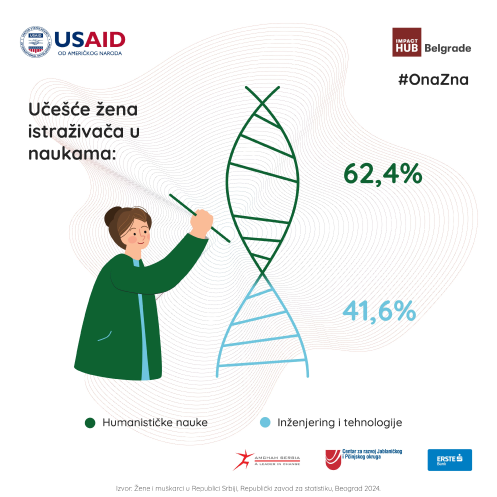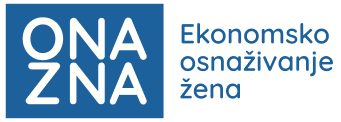
Empowered woman is the key to a healthy economy
Why is it so difficult to eradicate the legacy of gender roles in this day and age?

How do they shape our identity, access to education, business, self-development, and life in general? We talked about this and whether progress exists because changes are inevitable – with Gaia Montelatici, the founder of Impact Hub Belgrade. In the field of technology and entrepreneurship, few names resonate as loudly as Gaia Montelatici, the founder of Impact Hub Belgrade.
In a perfect balance of innovation, the fight for gender equality, diversity, and entrepreneurial work, Gaia has tirelessly created new paths in the fight for gender equality and women in the world of technology for two decades. The latest project, “She Knows,” supported by the USAID Mission in Serbia – deals with the economic empowerment of women. More about the project, its idea, and why women’s economic empowerment is a crucial issue of our time, we discuss with Gaia.

1. Why is women’s economic empowerment important for a society and what obstacles did you face when you started your entrepreneurial career?
Economic independence is a very powerful tool for achieving various goals, both for personal and societal progress. A situation where a person does not have the ability to independently decide and manage their work, the results of that work, and participation in economic activities – is actually a lack of economic rights, which in essence are nothing more than human rights. Gender roles are still a major obstacle, as they are present in the very functioning of individuals, families, society, institutions, and even the economy. They are dangerous precisely because we often no longer notice how they shape our identity, access to education, business, self-development, and life in general. Gender roles prescribe or prohibit certain behaviors, while limiting access to specific domains, all based on gender. Of course, such restrictions are not in the form of regulations or laws; they are more social rules, cultural beliefs, and practices passed down from generation to generation.
I had great support from the very beginning of starting Impact Hub. My children became independent very quickly, and together with other family members, they provided all the support I needed to engage in entrepreneurship. My life partner quickly recognized the business idea opportunity and joined, so we founded Impact Hub Belgrade together. However, I myself struggled with the idea – is it okay for me to engage in entrepreneurship when it might mean not spending enough time with my children? I wondered if I was providing enough for them? At the beginning, I felt a kind of guilt for being more dedicated to building my business than to my family. However, the desire to be a role model for my daughters prevailed – I wanted them to see that every woman can take the initiative and thus contribute to small but significant changes.
2. What roles, or tasks, are typically assigned to men and which to women?
Beliefs about the primary duties that women and men should perform still significantly influence women’s participation in the labor market or any type of economic activities they choose. Women are often expected to be the primary caregivers, which shapes the type of jobs they seek and where they are sought. The belief that a woman is the one who takes care of others is reflected in the increasingly common question about the balance between a woman’s professional and private life, a question that is actually just a byproduct of the idea of a woman as a caregiver and deepens gender prejudices.
When we do not recognize the strong impact of gender-based societal expectations, we suppress our real desires, aspirations, and the authentic power we have as women.
One reason why it is difficult to remove the legacy of gender roles is the so-called “pseudo-protection” that strictly defined gender roles offer, while causing and nurturing discrimination. The opinion that women are the “weaker sex” compared to men and that they are “more emotional” still persists. The first association is a tendency towards irrationality – thus, women are considered less suitable for STEM subjects. This is why, in the division of labor, in private, social, and public environments, we can still often see men being positioned as protectors, while women take on the role of caring for others – children, husband, parents, employees, team… Therefore, it is important to be aware of the presence of gender roles. To start with, it is important to examine how we make decisions regarding the choice of school, job, lifestyle, and even partner, because these choices often reflect society’s gender-based expectations that are not necessarily in line with our authentic desires.
3. Research from the Republic Statistical Office tells us that women’s participation in technology and engineering is only 41.6%. How can this number be increased?
The lack of women in leadership positions means that women do not have enough role models to look up to, which discourages them from aspiring to such positions from the start.
This topic is closely related to the leadership models we have in Serbia. Generally, leadership styles have begun to change, and the technology sector is definitely one of the most advanced in adopting modern, agile approaches to management and team leadership. However, the cultural vertical way of working, or hierarchical style, is still very present, which also implies that the leader bears the greatest responsibility. Although many men no longer identify with this leadership model, women in leadership positions often had to adopt it to be accepted. By doing so, they fit into the system but did not change it much from within, and it remained predominantly patriarchal. The irony grows when we realize that there is less and less evidence that such a vertical leadership model is effective for business.
It is important to recognize that we need different types of leaders, that women are equally capable and excellent in leading businesses, and that we should enable them to apply for and reach decision-making positions.
4. You launched the “She Knows” project supported by the USAID Mission in Serbia in collaboration with AmCham, USAID, Erste Bank, and the Center for Development of Jablanica and Pcinja Districts. Can you explain the goals of this project and who it is primarily intended for?
“She Knows” is a four-year activity aimed at the economic empowerment, especially of young women, particularly from rural areas and those not covered by education, employment, or training (NEET – not in education, not in employment, not in training), thus contributing to strengthening the domestic economy. The “She Knows” project is supported by the USAID Mission in Serbia and consists of three components: increasing women’s employment and employability; developing women-led businesses and increasing access to funds for female entrepreneurs; and enhancing companies’ capacity to implement gender-sensitive practices.
The pilot project will be implemented in the first year in the Jablanica and Pcinja districts, in partnership with the Center for Development of Jablanica and Pcinja Districts (CRJPO). The approach in implementing the pilot project in these districts is based on needs and capacity assessments obtained through consultations with the most relevant stakeholders, including the Development Agency of Serbia (RAS). We sought partners with experience, a developed network of collaborators, and potential for further growth. At the same time, we recognized that women in rural parts of Serbia are currently less supported and saw the need to focus more on them.
5. What is the duration of the project, and what are your plans for the future?
“She Knows” officially started on December 27, 2023, and will last for four years. This year, our focus is on the pilot project in the Jablanica and Pcinja districts, aiming to increase women’s employability and support female entrepreneurs, where we are collaborating with the partner organization Center for Development of Jablanica and Pcinja Districts through which we will award the first grants to selected female entrepreneurs from these districts. At the same time, with partner AmCham, we will support about thirty large companies in Serbia to improve their internal practices for greater inclusion of women in the company’s business development processes.
After the first year, the piloted support model for increasing women’s employment and access to finances for women-led businesses will be expanded to two more districts.
This implementation will be carried out in cooperation with local development agencies, which will be selected by the end of 2024.
At the end of the “She Knows” project, it is expected that the project will leave behind communities of women with increased resilience, confidence in their abilities to compete successfully in the labor market, both as employees and business owners. Empowered professionals are expected to take leadership positions in their workplaces and support younger women entering the professional world. Ultimately, the project should contribute to creating an improved working environment for women in the public and private sectors in Serbia, where bias and discrimination are reduced, and women’s economic participation is increased.
6. What advice would you give to girls and young women who want to build their careers in the world of technology and entrepreneurship?
First and foremost, I would tell them to believe in themselves, in their feelings and abilities, because they are an expression of their authentic strength and voice. Mistakes are not proof of incapacity and weakness, but a necessary part of learning. I would tell them to enjoy and play with technology; to expect that there will be moments of fear and difficulty, but that this is completely normal and that such moments are opportunities for great growth. I want them to meet different people from the fields of technology and entrepreneurship, from different industries and countries, and enrich their experiences and knowledge by exchanging opinions with them. Also, it is important to find their uniqueness and develop their personal approach in anything they wish to achieve. Let them measure their success by their progress, not by comparison with others.



